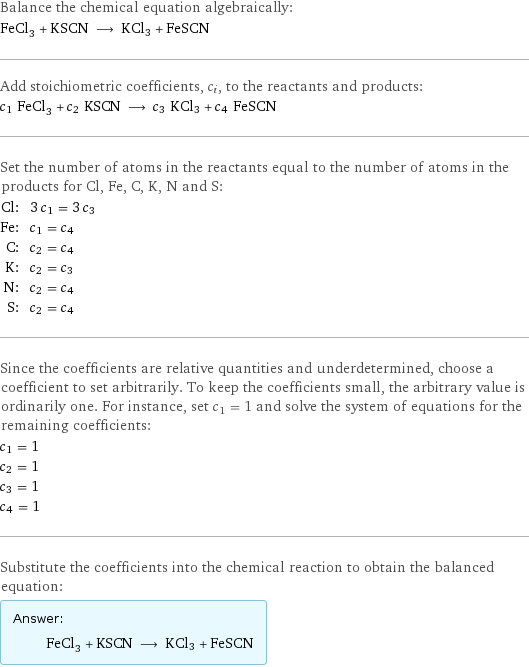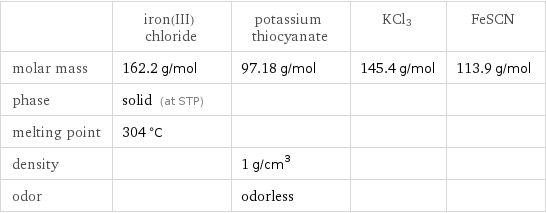Input interpretation

FeCl_3 iron(III) chloride + KSCN potassium thiocyanate ⟶ KCl3 + FeSCN
Balanced equation

Balance the chemical equation algebraically: FeCl_3 + KSCN ⟶ KCl3 + FeSCN Add stoichiometric coefficients, c_i, to the reactants and products: c_1 FeCl_3 + c_2 KSCN ⟶ c_3 KCl3 + c_4 FeSCN Set the number of atoms in the reactants equal to the number of atoms in the products for Cl, Fe, C, K, N and S: Cl: | 3 c_1 = 3 c_3 Fe: | c_1 = c_4 C: | c_2 = c_4 K: | c_2 = c_3 N: | c_2 = c_4 S: | c_2 = c_4 Since the coefficients are relative quantities and underdetermined, choose a coefficient to set arbitrarily. To keep the coefficients small, the arbitrary value is ordinarily one. For instance, set c_1 = 1 and solve the system of equations for the remaining coefficients: c_1 = 1 c_2 = 1 c_3 = 1 c_4 = 1 Substitute the coefficients into the chemical reaction to obtain the balanced equation: Answer: | | FeCl_3 + KSCN ⟶ KCl3 + FeSCN
Structures

+ ⟶ KCl3 + FeSCN
Names

iron(III) chloride + potassium thiocyanate ⟶ KCl3 + FeSCN
Equilibrium constant
![Construct the equilibrium constant, K, expression for: FeCl_3 + KSCN ⟶ KCl3 + FeSCN Plan: • Balance the chemical equation. • Determine the stoichiometric numbers. • Assemble the activity expression for each chemical species. • Use the activity expressions to build the equilibrium constant expression. Write the balanced chemical equation: FeCl_3 + KSCN ⟶ KCl3 + FeSCN Assign stoichiometric numbers, ν_i, using the stoichiometric coefficients, c_i, from the balanced chemical equation in the following manner: ν_i = -c_i for reactants and ν_i = c_i for products: chemical species | c_i | ν_i FeCl_3 | 1 | -1 KSCN | 1 | -1 KCl3 | 1 | 1 FeSCN | 1 | 1 Assemble the activity expressions accounting for the state of matter and ν_i: chemical species | c_i | ν_i | activity expression FeCl_3 | 1 | -1 | ([FeCl3])^(-1) KSCN | 1 | -1 | ([KSCN])^(-1) KCl3 | 1 | 1 | [KCl3] FeSCN | 1 | 1 | [FeSCN] The equilibrium constant symbol in the concentration basis is: K_c Mulitply the activity expressions to arrive at the K_c expression: Answer: | | K_c = ([FeCl3])^(-1) ([KSCN])^(-1) [KCl3] [FeSCN] = ([KCl3] [FeSCN])/([FeCl3] [KSCN])](../image_source/77a829fc393598663a180b974c6c8e14.png)
Construct the equilibrium constant, K, expression for: FeCl_3 + KSCN ⟶ KCl3 + FeSCN Plan: • Balance the chemical equation. • Determine the stoichiometric numbers. • Assemble the activity expression for each chemical species. • Use the activity expressions to build the equilibrium constant expression. Write the balanced chemical equation: FeCl_3 + KSCN ⟶ KCl3 + FeSCN Assign stoichiometric numbers, ν_i, using the stoichiometric coefficients, c_i, from the balanced chemical equation in the following manner: ν_i = -c_i for reactants and ν_i = c_i for products: chemical species | c_i | ν_i FeCl_3 | 1 | -1 KSCN | 1 | -1 KCl3 | 1 | 1 FeSCN | 1 | 1 Assemble the activity expressions accounting for the state of matter and ν_i: chemical species | c_i | ν_i | activity expression FeCl_3 | 1 | -1 | ([FeCl3])^(-1) KSCN | 1 | -1 | ([KSCN])^(-1) KCl3 | 1 | 1 | [KCl3] FeSCN | 1 | 1 | [FeSCN] The equilibrium constant symbol in the concentration basis is: K_c Mulitply the activity expressions to arrive at the K_c expression: Answer: | | K_c = ([FeCl3])^(-1) ([KSCN])^(-1) [KCl3] [FeSCN] = ([KCl3] [FeSCN])/([FeCl3] [KSCN])
Rate of reaction
![Construct the rate of reaction expression for: FeCl_3 + KSCN ⟶ KCl3 + FeSCN Plan: • Balance the chemical equation. • Determine the stoichiometric numbers. • Assemble the rate term for each chemical species. • Write the rate of reaction expression. Write the balanced chemical equation: FeCl_3 + KSCN ⟶ KCl3 + FeSCN Assign stoichiometric numbers, ν_i, using the stoichiometric coefficients, c_i, from the balanced chemical equation in the following manner: ν_i = -c_i for reactants and ν_i = c_i for products: chemical species | c_i | ν_i FeCl_3 | 1 | -1 KSCN | 1 | -1 KCl3 | 1 | 1 FeSCN | 1 | 1 The rate term for each chemical species, B_i, is 1/ν_i(Δ[B_i])/(Δt) where [B_i] is the amount concentration and t is time: chemical species | c_i | ν_i | rate term FeCl_3 | 1 | -1 | -(Δ[FeCl3])/(Δt) KSCN | 1 | -1 | -(Δ[KSCN])/(Δt) KCl3 | 1 | 1 | (Δ[KCl3])/(Δt) FeSCN | 1 | 1 | (Δ[FeSCN])/(Δt) (for infinitesimal rate of change, replace Δ with d) Set the rate terms equal to each other to arrive at the rate expression: Answer: | | rate = -(Δ[FeCl3])/(Δt) = -(Δ[KSCN])/(Δt) = (Δ[KCl3])/(Δt) = (Δ[FeSCN])/(Δt) (assuming constant volume and no accumulation of intermediates or side products)](../image_source/97bc105fa1b6edf96ff5476e91e41ce2.png)
Construct the rate of reaction expression for: FeCl_3 + KSCN ⟶ KCl3 + FeSCN Plan: • Balance the chemical equation. • Determine the stoichiometric numbers. • Assemble the rate term for each chemical species. • Write the rate of reaction expression. Write the balanced chemical equation: FeCl_3 + KSCN ⟶ KCl3 + FeSCN Assign stoichiometric numbers, ν_i, using the stoichiometric coefficients, c_i, from the balanced chemical equation in the following manner: ν_i = -c_i for reactants and ν_i = c_i for products: chemical species | c_i | ν_i FeCl_3 | 1 | -1 KSCN | 1 | -1 KCl3 | 1 | 1 FeSCN | 1 | 1 The rate term for each chemical species, B_i, is 1/ν_i(Δ[B_i])/(Δt) where [B_i] is the amount concentration and t is time: chemical species | c_i | ν_i | rate term FeCl_3 | 1 | -1 | -(Δ[FeCl3])/(Δt) KSCN | 1 | -1 | -(Δ[KSCN])/(Δt) KCl3 | 1 | 1 | (Δ[KCl3])/(Δt) FeSCN | 1 | 1 | (Δ[FeSCN])/(Δt) (for infinitesimal rate of change, replace Δ with d) Set the rate terms equal to each other to arrive at the rate expression: Answer: | | rate = -(Δ[FeCl3])/(Δt) = -(Δ[KSCN])/(Δt) = (Δ[KCl3])/(Δt) = (Δ[FeSCN])/(Δt) (assuming constant volume and no accumulation of intermediates or side products)
Chemical names and formulas

| iron(III) chloride | potassium thiocyanate | KCl3 | FeSCN formula | FeCl_3 | KSCN | KCl3 | FeSCN Hill formula | Cl_3Fe | CKNS | Cl3K | CFeNS name | iron(III) chloride | potassium thiocyanate | | IUPAC name | trichloroiron | potassium isothiocyanate | |
Substance properties

| iron(III) chloride | potassium thiocyanate | KCl3 | FeSCN molar mass | 162.2 g/mol | 97.18 g/mol | 145.4 g/mol | 113.9 g/mol phase | solid (at STP) | | | melting point | 304 °C | | | density | | 1 g/cm^3 | | odor | | odorless | |
Units
